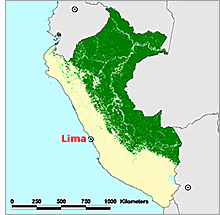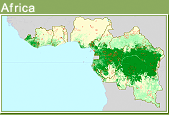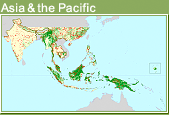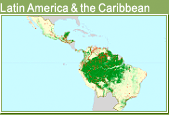Country details
Status of Tropical Forest Management 2005
Latin America & the Caribbean
Peru

©UNEP-WCMC 2004
Over the past three years, Peru has taken significant steps towards integrating the forest sector into the broader macroeconomic objectives of sustainable development. The new forestry and wildlife law embodies the forest policy of the country and prescribes several options for SFM and reforestation. An independent forest-control mechanism has been established and a broad coalition of stakeholders from the public and private sectors and civil society works together to develop joint approaches to SFM. Nevertheless, Peru still faces some major challenges in enforcing and applying regulations and planning instruments in the country's vast Amazon forests.
Key points
- Peru has a large forest resource with good potential for sustainable management.
- The PFE comprises an estimated 24.6 million hectares of natural production forest, 200,000–300,000 hectares of plantations and 16.3 million hectares of protection forest. A further 19.1 million hectares of forest have not yet been allocated.
- At least 560,000 hectares of production PFE and 1.54 million hectares of protection PFE are being managed sustainably. Moreover, large areas of the protection PFE, even if not formally under SFM, are under no imminent threat due to their remoteness.
- 59,600 hectares of natural forests have been certified in indigenous territories.
- The deforestation rate of about 269,000 hectares per year is one of the highest in the region; it is caused largely by the influx of settlers to the Amazon region and subsequent clearance for agriculture.
- A new forestry and wildlife law and its regulations were approved in 2000/2001, a national forest strategy was adopted in 2004 and a national reforestation plan was prepared in 2005.
- The forestry and wildlife law is a bold initiative to promote SFM; its effective implementation will probably require substantial investments in human resources in both the public and private sectors.
- Among other things, the new law sets out the parameters of a new concession system.
- An independent forest control and supervision agency has been created to oversee the implementation of this new system.
- The financial viability of SFM will depend in large measure on the prices that can be obtained for a range of lesser-known species.
- There are many informal forest operations, especially linked to caoba and cedro, but these species are becoming economically scarcer. Harvesting pressure for such timbers is increasing both in protected areas and in forests belonging to indigenous communities.
- The capacity to implement SFM at the field level is low, although considerable efforts are being made to address this through training and technical assistance.

 Africa
Africa  Asia & the Pacific
Asia & the Pacific  Latin America & the Caribbean
Latin America & the Caribbean